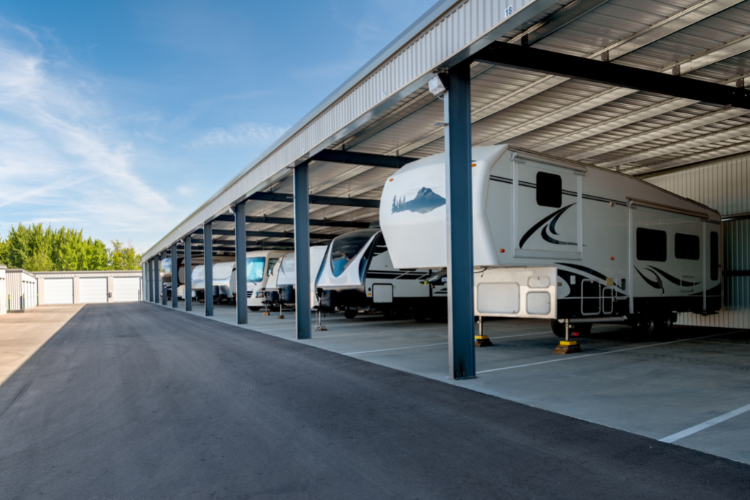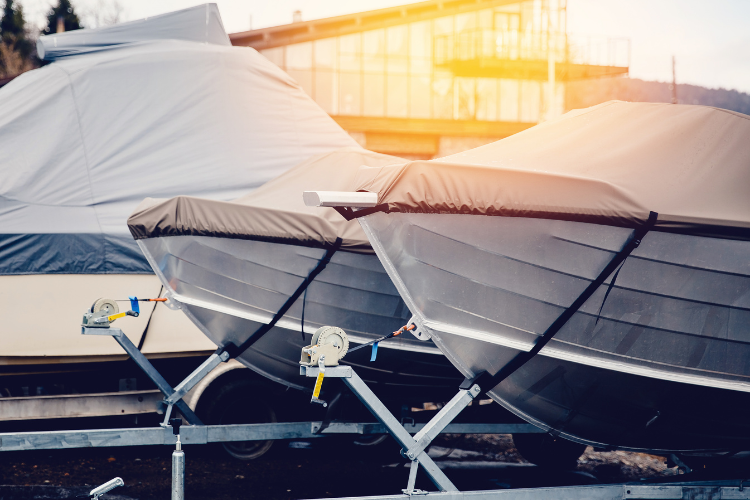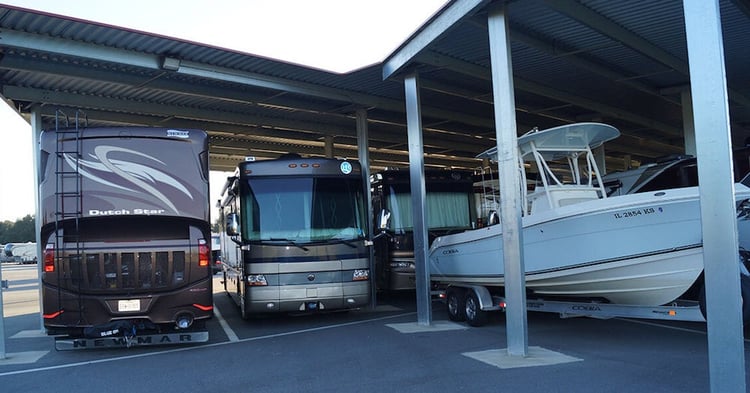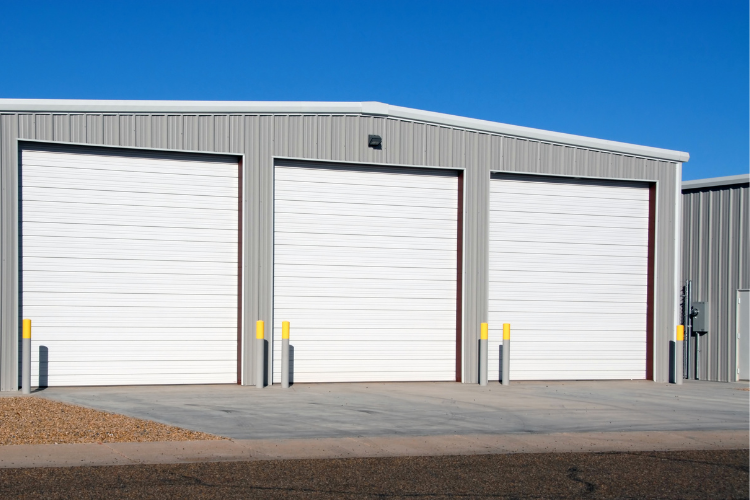RV ownership is at a record high with more than 11 million American households owning an RV in 2021. In addition, there are a total of 17 million recreational boats currently in use in the United States. Of course, not everyone can park their RV or boat in their driveway, which makes RV and boat storage a necessity – and a great opportunity for self storage owners wondering how to start a boat and RV storage business.
Storelocal recently hosted a members-only virtual call with RV Storage Depot’s Scott Ramser, who’s been in the RV and boat storage business since the mid-1980s. He shared his expert opinions on all matters, and while the material covered during these members-only calls is generally not shared with the public, the popularity of this particular conversation inspired us to make it available to everyone.
The Evolution of RV & Boat Storage
RV and boat storage used to be a pretty simple affair, with most “facilities” usually consisting of nothing more than a barely developed piece of land roped off with a padlocked chain-link fence. Today, RV and boat storage facilities are integrating self storage disciplines into the business to bring in greater profits, offering tenants different storage types and a host of amenities to bring in greater profits, as well as following lien law, providing rental contracts, and engaging in modern marketing methods.

While some RV and boat storage facilities remain standalone, others include self storage units to give RV and boat owners a place to store items they don’t want to take on their RV or boating trip when picking up their vehicle, towable, or watercraft. There are five main types of RV and boat storage facilities:
- Open storage. These range from the dirt fields and chain-link fences of the past to fully paved or concrete stalls.
- Outdoor covered storage. Similar to open storage, but with canopies or roof-only structures for added protection against the elements.
- Bullpen valet storage. Large warehouses with concierge parking.
- Enclosed storage. High-end, fully enclosed single-story units are most common in affluent markets.
- Condo storage. Enclosed storage facilities that offer opportunities for ownership rather than rental.
Of course, any facility may offer a combination of these five types of storage options, and many do, offering outdoor self-parking, indoor valet parking, and a wide mix of amenities.
RV & Boat Storage Feasibility Studies
Research shows that more and more Americans, starved for recreational outlets due to the pandemic, have been snatching up RVs and boats. This has resulted in storage operators reporting increased demand for RV and boat spaces. In addition, because of this demand, storage brokers are saying owners of RV and boat storage facilities are less willing to sell, making it an owner’s market for RV and boat storage. Of course, not all markets will experience the same level of demand. So, how do you determine supply and demand metrics when conducting a feasibility study?

While looking at the number of registered RVs or boats in a market may seem to be a good indicator of potential demand, the best bet is to treat an RV and boat feasibility study much like a self storage feasibility model. Research should look at the competition in the market, delving into their size and existing inventory of parking spaces.
It’s also important to take note of which type of facility they offer and whether there’s an opportunity to provide a different type of service (for example, if the competition consists mainly of open or outdoor covered storage, but there is a highly affluent demographic within the market, building enclosed RV and boat storage units that they’d be willing to pay a premium for might be a good differentiator or vice versa).
When conducting a feasibility study and projecting lease-up velocity, you’ll want to use any historical lease-up information you can gather and then make adjustments for current market conditions. A good rule of thumb is an absorption schedule of one unit per day. But, remember that even as you’re renting units, you’ll also have move-outs after the first of every month. So, consider net absorption. That is, if you have 600 units, don’t think you’ll be on a 600-day schedule; it could be more like 730 days when factoring in move-outs.
Site Selection: Building an RV & Boat Storage Facility
Laws that regulate the parking of boats and RVs in driveways, yards, and streets are gaining enforcement in even the smallest towns, making storage facilities even more valuable. So, you’ll want to look for properties near communities that prohibit RV and boat parking. Then, be sure to do your proper due diligence, assessing how much you can afford to pay for a piece of land based on the amount of rent per square foot and anticipated construction costs.

Consider Distance
While a convenient and visible location for RV storage facilities is always going to be best, it’s worth noting that many RV and boat owners are typically willing to travel longer distances versus a traditional self storage facility (a 20-mile radius is acceptable, versus a 3-5 mile radius for self-storage).
In fact, a lot of “weekend warriors” will often consider locations that are near their business or office versus their home; that’s because they like to park their passenger car at the facility after work, hitch up their RV for a weekend trip, and then swap them back out when they return. On the other hand, boaters will seek out locations next to bodies of water that they can trailer their boat to.

Planning the Design
Once a site has been selected, the design must be carefully considered (this will, of course, vary based on which of the five types of facilities you plan to build).
A good rule of thumb is to plan for 65 units to the acre (this includes common areas and parking spaces). When laying out the lot, don’t restrict traffic flow; ease of access is critical (also leave enough room at the entrance to allow for “stacking,” when multiple vehicles are waiting to enter. The wider you can make aisles, the better (50’ for enclosed units, 45’ for angled canopy spaces). Speaking of angles, a 60-degree angle is ideal as it helps the driver use their side mirror for backing in safely.
Site Selection: Buying an RV or Boat Storage Facility
While finding an RV or boat storage facility owner that’s willing to sell may be more difficult these days, it’s typically a lot less risky of an investment than building a facility. That’s mainly because of zoning. Zoning laws dictate how property can or cannot be used, so although you may find an ideal location for your facility, that doesn’t mean the authorities are going to allow you to build on it.

Rezoning & HOAs
While you can always attempt to rezone the land, this can be a long, expensive process, with no guarantee that you’ll come out on top. In addition, if a facility already exists, you won’t have to deal with neighborhood associations pushing back. Many HOAs have recently begun restricting new structures or demanding that they follow certain designs in order to avoid the development of an “eyesore” in their area.

Upgrades To Consider
Of course, the existing facility may need some work, but this is an opportunity to make improvements that will allow you to charge more for rent. For example, you may want to consider adding these upgrades:
- Motorized door operators on the units (a rolling lift is preferable to the flimsier vertical lifts)
- Power hookups (consider Individually metered electricity in the units as an added benefit)
- Wash bay (a gangway that allows owners to walk the length of the vehicle and clean it really adds value)
- Dump station (it’s recommended that this, along with the wash station, be located at the front of the facility for customer convenience and for passerbyers to see it and realize its value)
- Ice machine (to allow tenants to fill up before hitting the road or the water)
- Retail RV and boating supplies for sale in the management office (at a minimum, consider offering wheel or hitch locks to prevent theft)
- Security features (access gates, automated entry, lot and keypad cameras, etc). Be sure that camera images are displayed on monitors in the sales office, making this a visible selling point).
RV & Boat Storage Pricing
Boat and RV storage pricing will vary from market to market, as well as the type of facility and the amenities offered. While some RV and boat facilities have set prices, most price by the lineal foot or square foot; it’s up to the individual facility owner.
A few things to keep in mind:
- Specify in rental agreements how a temporarily vacant spot will be handled. For example, if a tenant is not paying month-to-month, you may state that their same spot is not guaranteed unless they pay for it while they are gone. Conversely, you may state that you reserve the right to rent their spot out while they are gone as long as the new tenant will be gone by the time the original tenant returns.
- Be careful with rent increases. Unlike a traditional self storage unit, which would require a tenant to come to collect all their belongings and haul them somewhere else (something most people don’t want to do), an RV or boat owner can simply come in, hitch up their trailer, and pull their vehicle or boat away. This is especially important to consider if there are known vacancies in your area at lower-priced facilities.
The Future of RV and Boat Storage
The future of RV and boat storage looks bright! According to the RV Industry Association (RVIA), millennials are now more interested in buying an RV than any other age demographic, and their interest in RVing is positively impacting sales numbers.

This means, of course, that they’ll need somewhere to store their vehicle (or watercraft) especially with communities cracking down on boat and RV parking in driveways, yards, or streets. That’s not all; many people are also looking for places to store ATVs and jet skis. A spot carved out for an RV can easily accommodate multiple trailers carrying these recreational vehicles and watercrafts, potentially doubling the spot’s value for owners.
Like what you read here today? We covered much more on the Storelocal members-only call, including RV and boat facility insurance, delinquency auctions and liens, and a deeper dive into pricing. To be a part of the conversation in the future, join Storelocal today!


